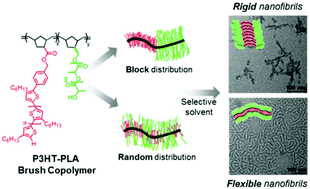当前位置:
X-MOL 学术
›
Polym. Chem.
›
论文详情
Our official English website, www.x-mol.net, welcomes your feedback! (Note: you will need to create a separate account there.)
Solution self-assembly of poly(3-hexylthiophene)–poly(lactide) brush copolymers: impact of side chain arrangement†
Polymer Chemistry ( IF 4.6 ) Pub Date : 2018-05-21 00:00:00 , DOI: 10.1039/c8py00627j Suk-kyun Ahn 1, 2, 3, 4 , Jinwoo Nam 4, 5, 6, 7, 8 , Jiahua Zhu 9, 10, 11, 12 , Eunji Lee 4, 8, 13, 14 , S. Michael Kilbey 12, 15, 16, 17
Polymer Chemistry ( IF 4.6 ) Pub Date : 2018-05-21 00:00:00 , DOI: 10.1039/c8py00627j Suk-kyun Ahn 1, 2, 3, 4 , Jinwoo Nam 4, 5, 6, 7, 8 , Jiahua Zhu 9, 10, 11, 12 , Eunji Lee 4, 8, 13, 14 , S. Michael Kilbey 12, 15, 16, 17
Affiliation

|
We exploit the crowded intramolecular environment of brush copolymers and π–π interactions of poly(3-hexylthiophene) (P3HT) side chains to produce tailorable nanostructures by self-assembly in solution. A series of brush copolymers consisting of regioregular P3HT and amorphous poly(D,L-lactide) (PLA) side chains grafted on a poly(norbornene) backbone are synthesized via ring-opening metathesis polymerization (ROMP) of norbornenyl-functionalized P3HT and PLA macromonomers. Three P3HT–PLA brush random copolymers and three brush block copolymers are prepared to create pairs of brush random and block copolymers containing comparable composition ratios of P3HT and PLA side chains. The relative volume fraction of P3HT and PLA side chains in the brush copolymers dictates thermal properties and crystallinity with little dependency on the side chain arrangement. However, the nanoscale morphologies of brush copolymers in a selective solvent are significantly altered by the side chain arrangement as well as copolymer composition. The different self-assembly behaviors in solution are attributed to the molecular design: in the brush block copolymers, self-assembly is driven by P3HT crystallization through both intra- and intermolecular π–π interactions, but intramolecular π–π interactions are largely suppressed in the brush random copolymers. Thus, tailoring brush copolymer architecture during synthesis enables additional levels of control over π–π interactions between P3HT side chains that are not present in conventional linear P3HT-based copolymers. The ability to use macromolecular chain topology as a way to access or tailor π-conjugated nanostructures may be beneficial in the context of controlling morphology at the nanoscale or producing patterned thin films for optoelectronic applications.
中文翻译:

聚(3-己基噻吩)-聚(丙交酯)刷式共聚物的溶液自组装:侧链排列的影响†
我们利用拥挤的刷式共聚物分子内环境和聚(3-己基噻吩)(P3HT)侧链的π-π相互作用通过在溶液中自组装产生可定制的纳米结构。通过以下方法合成了一系列由区域规则的P3HT和接枝到聚降冰片烯骨架上的无定形聚D,L-丙交酯(PLA)侧链组成的刷式共聚物降冰片烯基官能化的P3HT和PLA大分子单体的开环易位聚合(ROMP)。制备了三种P3HT-PLA刷子无规共聚物和三种刷子嵌段共聚物,以创建成对的刷子无规共聚物和嵌段共聚物,这些共聚物包含可比的P3HT和PLA侧链组成比。刷子共聚物中P3HT和PLA侧链的相对体积分数决定了热性能和结晶度,而对侧链排列的依赖性很小。但是,在选择性溶剂中刷式共聚物的纳米级形态会因侧链排列以及共聚物组成而发生显着变化。溶液中不同的自组装行为归因于分子设计:在刷嵌段共聚物中,P3HT结晶通过分子内和分子间π-π相互作用驱动自组装,但在刷无规共聚物中分子内π-π相互作用被大大抑制。因此,在合成过程中调整刷子共聚物的结构可以实现对P3HT侧链之间π-π相互作用的额外控制,而这在传统的线性P3HT基共聚物中是不存在的。使用大分子链拓扑结构作为访问或定制π共轭纳米结构的方法的能力在控制纳米尺度上的形态或生产用于光电应用的图案化薄膜的背景下可能是有益的。在合成过程中调整刷式共聚物的结构可以提高对P3HT侧链之间π-π相互作用的控制水平,而在传统的线性P3HT基共聚物中则不存在。使用大分子链拓扑结构作为访问或定制π共轭纳米结构的方法的能力在控制纳米尺度上的形态或生产用于光电应用的图案化薄膜的背景下可能是有益的。在合成过程中调整刷式共聚物的结构可以提高对P3HT侧链之间π-π相互作用的控制水平,而在传统的线性P3HT基共聚物中则不存在。使用大分子链拓扑结构作为访问或定制π共轭纳米结构的方法的能力在控制纳米尺度上的形态或生产用于光电应用的图案化薄膜的背景下可能是有益的。
更新日期:2018-05-21
中文翻译:

聚(3-己基噻吩)-聚(丙交酯)刷式共聚物的溶液自组装:侧链排列的影响†
我们利用拥挤的刷式共聚物分子内环境和聚(3-己基噻吩)(P3HT)侧链的π-π相互作用通过在溶液中自组装产生可定制的纳米结构。通过以下方法合成了一系列由区域规则的P3HT和接枝到聚降冰片烯骨架上的无定形聚D,L-丙交酯(PLA)侧链组成的刷式共聚物降冰片烯基官能化的P3HT和PLA大分子单体的开环易位聚合(ROMP)。制备了三种P3HT-PLA刷子无规共聚物和三种刷子嵌段共聚物,以创建成对的刷子无规共聚物和嵌段共聚物,这些共聚物包含可比的P3HT和PLA侧链组成比。刷子共聚物中P3HT和PLA侧链的相对体积分数决定了热性能和结晶度,而对侧链排列的依赖性很小。但是,在选择性溶剂中刷式共聚物的纳米级形态会因侧链排列以及共聚物组成而发生显着变化。溶液中不同的自组装行为归因于分子设计:在刷嵌段共聚物中,P3HT结晶通过分子内和分子间π-π相互作用驱动自组装,但在刷无规共聚物中分子内π-π相互作用被大大抑制。因此,在合成过程中调整刷子共聚物的结构可以实现对P3HT侧链之间π-π相互作用的额外控制,而这在传统的线性P3HT基共聚物中是不存在的。使用大分子链拓扑结构作为访问或定制π共轭纳米结构的方法的能力在控制纳米尺度上的形态或生产用于光电应用的图案化薄膜的背景下可能是有益的。在合成过程中调整刷式共聚物的结构可以提高对P3HT侧链之间π-π相互作用的控制水平,而在传统的线性P3HT基共聚物中则不存在。使用大分子链拓扑结构作为访问或定制π共轭纳米结构的方法的能力在控制纳米尺度上的形态或生产用于光电应用的图案化薄膜的背景下可能是有益的。在合成过程中调整刷式共聚物的结构可以提高对P3HT侧链之间π-π相互作用的控制水平,而在传统的线性P3HT基共聚物中则不存在。使用大分子链拓扑结构作为访问或定制π共轭纳米结构的方法的能力在控制纳米尺度上的形态或生产用于光电应用的图案化薄膜的背景下可能是有益的。



























 京公网安备 11010802027423号
京公网安备 11010802027423号